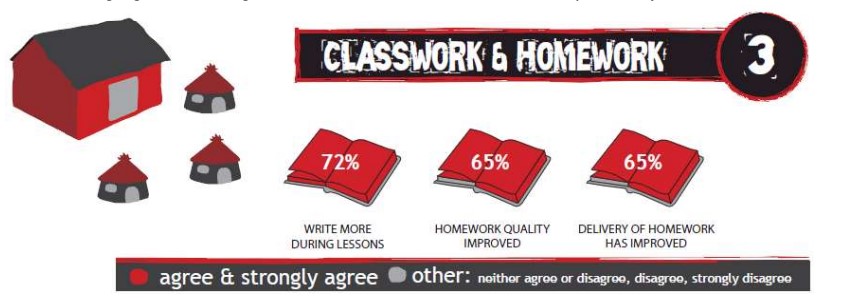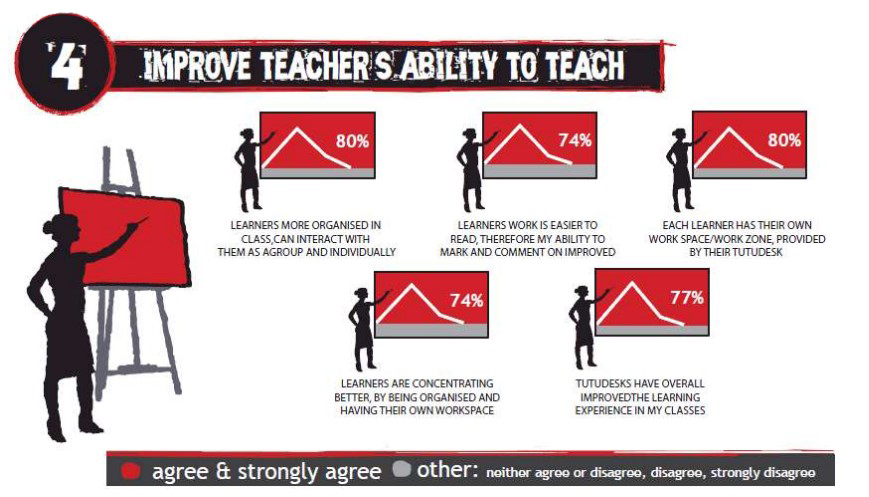The development of fit-for-purpose infrastructure requires insight into multiple scenarios and needs. Insight that can only be achieved through years of direct experience, research and development. The Tutudesk is designed to offer infrastructure that covers more than just a singular solution.
With literacy development as the cornerstone, we can begin to build out on other impact. To achieve value from investment, education infrastructure provision must affect more than one area. Together with assisting literacy, Tutudesk offers a portable and fast solution impacting:
Learner Experience
The human context is a driving force behind our work. Facts and figures offer only a part of the whole picture. Empathy, the ability to understand the daily experience of learners, is a cornerstone of our motivation. We need to comprehend fully what is like to go to school without a writing surface.
From our research study:
Medwell, et al. (2008) comment that handwriting difficulties are generally coupled with motivational difficulties and Feder (2007) warns that students with handwriting problems typically have difficulty in keeping up with the volume of written work.
This may detrimentally affect academic progress, which in turn leads to lowered self-esteem and behavioural issues. Feder (2007) continues to say that students’ intelligence or capabilities are often seen to be reflected in handwriting and students with poor handwriting commonly receive lower marks.

Homework
We all did it, we all hated it, but it had to be done. Homework is still a fundamental part of schooling. In context of the African education experience with overcrowded classes, desk shortages and underfunding, homework is a vital part of achieving results. It is too often that our constituents do not have a dedicated workspace at home, and the Tutudesk portability allows for this space at home.
From our research study:
A key component of a child’s education is homework. It provides the opportunity for the student to study in their own time, perhaps to test their knowledge of the skills they have been taught during the day in class or to prepare for a new topic in the next lesson. A review by researchers at Duke University of more than 60 research studies on homework between 1987 and 2003 showed that, within limits, there is a positive interaction between the amount of homework which is done and student achievement.
Most rural learners live under very poor conditions at home, where the family may have only one table, if any, that has to serve for all needs within the family unit. This can make it challenging for the student to find an opportunity to use the table. As within the classroom environment, the lack of a writing surface leads to similar challenges for the student and can hinder their educational performance.
When designing the Tutudesk the need for the provision of a writing surface at home was also a key consideration. As such, the Tutudesk is lightweight, weighing less than 1kg, and has a built-in handle, making it very easy for the child to carry to and from school. The proprietary blend of base material further ensures longevity.

Classroom Situation and the Teacher’s Ability to Teach
Education in Sub Saharan Africa dishes up more than a few challenges to our learners. Often lessons are conducted outside or in cramped indoor environments due to overcrowding of classrooms – particularly in primary schools. This directly impacts our teacher’s abilities from comfort and control to discipline.
From our research study:
When considering the layout of the classroom it is important to take into account the situation across much of Africa today. Most countries are facing a severe shortage of classrooms and so many students are taught whilst sitting outside under a tree and those who are in classrooms often suffer from issues of overcrowding. Having already highlighted the importance of a writing surface for a child’s education, it is now crucial to recognise that a suitable writing surface solution needs to work in the environment facing African children today, i.e. both inside and outside the classroom, when children are seated on the floor or on chairs.
In addition, when considering the layout of a classroom, the notion that a teacher standing in front of a class of children (seated at traditional school desks) is the best method of learning, should be reconsidered. Kennedy (2010, p21) posits that flexibility in approaches is necessary, considering that some learners respond better to hands-on experiences, more informal settings or small-group interactions with fellow learners.
This is supported by Pace and Price (2005) who point out that seating arrangements and related variables such as classroom position and so forth, have shown to impact on educational interactions.
Therefore, schools should obtain classroom furnishings that facilitate teachers to make more spontaneous changes to the classroom environment, allowing the nature of a task to dictate the required seating arrangements.
